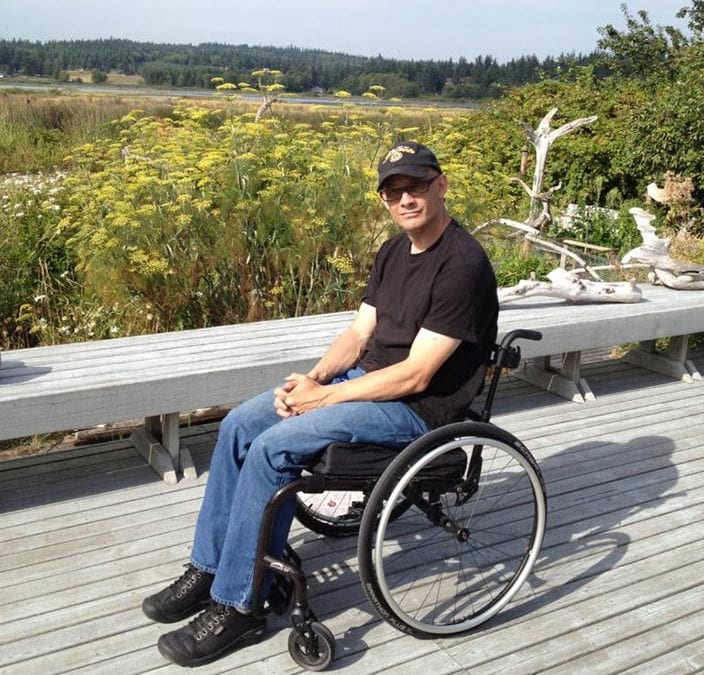The subject line read, “Just diagnosed with AMN.” Aaron from Auburn found my blog. He went on to tell me about his initial symptoms with our condition. He wrote about his family, his faith, and his fears. We shared an uncertain future and the same area code. Would I be willing to talk? He wanted to connect with someone who had experienced events and emotions that he will soon face.
Smart guy.
I did not seek out others when I was at his stage almost twenty years ago. Perhaps it was the shock, the shift from temporary complaints to a chronic condition. I sensed I was unusual. I knew I was idiosyncratic. None of the experts I consulted could name a single sufferer. I felt like Patient Zero. My experience exposed a hidden family history. But now science could identify the generic marker and could plot carriers. So how was I going to carry this load? I thought that if I could deal with my disease, that if I was okay with it, then others would be, too. I didn’t get too far ahead of myself in those days. I still don’t. I tackled the most immediate problems. I set goals: finishing grad school, learning how to drive with my hands, creating an accessible living space, comparing wheelchairs, finding a job.
As in most cases of helping, I think I got more than I gave. We shared diagnosis stories, how we were pushed by loved ones to investigate balance issues and irregular gait. He asked questions about my progression from cane to crutches to wheelchair. I did my best to be a calming, reassuring presence, focusing on practicalities. Anyone with chronic pain knows how overwhelming those practicalities can feel. So I worked through some of the biggest issues I faced and laid out my strategies.
It was a relief to unload, a little, to find common cause. On the road home, however, long-suppressed emotions hit. Why was I so isolated? Was it personal inclination? I lamented not having an AMN partner along this journey. That luncheon showed me how alone I had been. But I had also made a vow to break through my own shell. Aaron reminded me why I started this blog. It is my attempt to connect across so many lines and through so much noise and constant static, mostly my own. It is my cry in the wilderness. It is my hope that in expressing my truth, I might help you get closer to yours.


Excellent, compassionate essay.
As always, you articulate ideas a reader may vaguely harbour but hasn’t yet put into words . . . So moving. Thanks.
Lovely.
I have a dear friend who lives in Seattle. Her name is Kirste and she is obsessed with Gus – well, with corgies in general and Gus in specific. I had a mountain bike accident last year and injured my spinal cord with a result of paraplegia (t6/t7). While I was in rehab, my friend told me about your website and it inspired me to (eventually) start a blog of my own. I was also inspired to fetch around for a similar system to the one you have developed to put markers on accessible places, but I think someone else here in New Zealand is trying to do the same thing. Instead, I offered to help rather than elbowing in. Gee, this is quite a lot of detail. What I wanted to say was that the isolation is real, I’ve felt it, and you helped me not to. We clearly didn’t have the same path to the chair, but here we are. Thanks for posting and for caring and for being a good advocate.
Oh, Claudia. Thank you for reaching out. I am glad to know that Gus has become an ambassador. It has long been my hope to reduce isolation, whatever one’s path to the chair. Please share the details of your blog with me. I’d love to keep in touch. Do let me know if you visit your friend, Kirste, in Seattle. We must introduce her to Gus.
Hi Randy – my blog is here http://myeyesforward.net/
Found it! I loved “I’ve got me on my sleeve,” especially this realization: “huh, that’s what pity looks like.” And now I’ve got a new word for looky-loos, “gawky.” I’m most aware of it on vacation. Last weekend I visited my in-laws in British Columbia where I experienced a kinder, gentler “gawky.” I tried to lean into it, greeting people who were looking at me and engaging in conversation. It’s hit and miss. I did strike up a solid conversation with a fellow baseball fan. So there’s that.
Mostly, I can ignore the gawks, and like you, I try to say g’day or acknowledge them with a quick smile. Sometimes I think people feel ‘busted’ and maybe a little embarrassed that they’ve been caught staring. I don’t mind busting them, but in a friendly ‘drawing their awareness to it’ kind of way. I have a dog in training as a mobility service dog, and she is really striking, so people often look at her first and then me. She’s a good ice breaker. I’m glad you got at least one good conversation from your experiment.
Good call. Friday is a beauty. I shudder to think what life would be like without Gus.